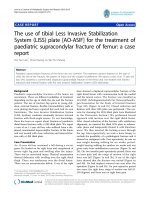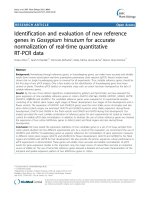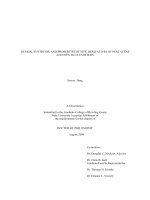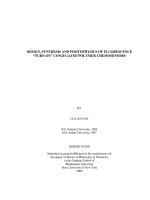design, synthesis, and biological evaluation of new anti-cancer nitrogen-containing combretastatins and novel cysteine protease inhibitors for the treatment of chagas
Bạn đang xem bản rút gọn của tài liệu. Xem và tải ngay bản đầy đủ của tài liệu tại đây (18.19 MB, 516 trang )
UMI Number: 3195285
3195285
2006
UMI Microform
Copyright
All rights reserved. This microform edition is protected against
unauthorized copying under Title 17, United States Code.
ProQuest Information and Learning Company
300 North Zeeb Road
P.O. Box 1346
Ann Arbor, MI 48106-1346
by ProQuest Information and Learning Company.
Copyright © 2005 by Rogelio Siles
All rights reserved
ABSTRACT
Design, Synthesis, and Biological Evaluation of New Anti-cancer Nitrogen-Containing
Combretastatins and Novel Cysteine Protease Inhibitors for the Treatment of Chagas
Rogelio Siles
Mentor: Kevin G. Pinney, Ph.D.
In an effort to combat cancer, the development of a relatively new type of anti-
cancer drugs known as vascular disrupting agents (VDAs) seems to be a promising
clinical approach. VDAs selectively interfere with blood flow in the microvessels that
carry nutrients and oxygen to the tumor. Blockage of these vessels will stop tumor
growth, produce necrosis, and hence prevent proliferation of cancer cells through the
body. The discovery of a group of VDAs known as combretastatins (CA) has sparked an
exciting area of anti-cancer drug discovery due to their robust biological activity as
evidenced through clinical success, particularly for combretastatin A-4 phosphate (CA-
4P) and one nitrogen-based combretastatin CA-4 analogue, AVE8062 which are
currently in clinical development. Herein, a small library of seventeen new synthetic
oxygen and nitrogen-bearing CA-1 and CA-4 analogues is described. Three of these
analogues showed significant inhibition of tubulin assembly (IC
50
= 2-3 µM) as well as in
vitro cytotoxicity against selected human cancer cell lines and in vivo blood flow
reduction in SCID mice (23-25% at 10 mg/Kg) suggesting that they have potential for
further prodrug modification and development as vascular disrupting agents for the
treatment of solid tumor cancers.
A separate research project has concentrated on the development of cysteine
protease inhibitors, primarily focused toward the inhibition of cruzain, the major cysteine
protease of Trypanosoma cruzi which is the agent of the parasitic disease called Chagas’
disease. Currently there is no satisfactory treatment for this disease, and the two accepted
drugs, nifurtimox and benznidazole, are associated with significant clinical toxicity. A
library of fourteen small non-peptidic thiosemicarbazones has been successfully
designed, synthesized and tested against cruzain and cathepsin L from which five
compounds showed significant cruzain inhibition in the low namolar range. Although
the most active compound synthesized, which is a bromotetrahydronaphthalene
thiosemicarbazone, exhibited an IC
50
=12 nM against cruzain, it also showed activity
against cathepsin L (IC
50
=134 nM). This new pharmacophore introduced may prove
useful as a lead compound for further optimization. In addition, this research revealed
further insights into the complex structure-activity relationship parameters which may
lead to the further development of more selective cruzain inhibitors.
TABLE OF CONTENTS
List of Figures vii
List of Tables x
List of Schemes xi
List of Abbreviations xiii
Acknowledgments xvii
Dedication xix
Chapter One: Introduction 1
Chapter Two: Synthesis and Biological Evaluation of Novel Combretastatin
Vascular Disrupting Agents 4
Introduction 4
Background 8
Carcinogenesis and the Cell Cycle 8
Targets for Cancer Chemotherapy 10
Vascular-Targeting Therapies 13
Antiangiogenic Therapy 16
Vascular Disrupting Agents 19
Small Molecule Vascular Disrupting Agents 22
Tubulin Binding Agents 23
Colchicine-Binding Site Agents 31
iii
Chapter Three: Materials and Methods 38
General Section 38
Synthesis of Nitrogen-Based Combretastatin A-4 39
Synthesis of Nitrogen-Based Combretastatin A-1 49
Synthesis of a Combretastatin A-1 Analogue 62
Synthesis of Nitrogen-Based Epoxide Derivatives of Combretastatins
A-1 and A-4 66
Synthesis of Cold Precursors of Radio-labeled Combretastatins
CA-1 and CA-4 70
Synthesis of OXi8007 and a Nitrogen-Based Indole 75
Biological and Biochemical Evaluation 82
Tubulin polymerization assay 82
MTT assay 84
In vitro cytotoxicity studies 84
Blood flow reduction 85
Chapter Four: Results and Discussion 86
Synthesis of Nitrogen-Based Combretastatin A-4 86
Synthesis of Nitrogen-Based Combretastatin A-1 100
Synthesis of a Combretastatin A-1 Analogue 112
Synthesis of Nitrogen-Based Epoxide Derivatives of Combretastatins
A-1 and A-4 114
Synthesis of Cold Precursors of Radio-labeled Combretastatins CA-1
and CA-4 117
Synthesis of OXi8007 and a Nitrogen-Based Indole 122
Biological and Biochemical Results 131
iv
Inhibition of tubulin polymerization, cytotoxicity (MTT)
and blood flow reduction 132
In vitro cytotoxicity against P388 and selected human cancer
cell lines 134
Chapter Five: Conclusions and Future Directions 140
Chapter Six: Synthesis, Design and Biochemical Evaluation of Cysteine
Protease Inhibitors: Novel Compounds for Chagas’ Disease
Treatment 143
Introduction 143
Background 144
Chemotherapy of Chagas’ Disease 148
Chapter Seven: Materials and Methods 157
General Section 157
Synthesis of Propiophenone Thiosemicarbazone Derivatives 158
Synthesis of Benzophenone Thiosemicarbazone Derivatives 165
Synthesis of Tetrahydronaphthalene Derivatives 168
Biochemical Evaluation of Cruzain Inhibitors 189
Cruzain Inhibition 190
Human Liver Cathepsin L 190
Chapter Eight: Results and Discussion 191
Synthesis of Propiophenone Thiosemicarbazone Derivatives 191
Synthesis of Benzophenone Thiosemicarbazone Derivatives 196
Synthesis of Tetrahydronaphthalene Derivatives 199
v
Biochemical Evaluation of Cruzain Inhibitors 212
Chapter Nine: Conclusions and Future Directions 221
Appendices 228
NMR spectra 229
Appendix A: Vascular Disrupting Agents 240
Appendix B: Cysteine Protease Inhibitors 379
References 483
vi
LIST OF FIGURES
2.1. Major types of cancer that will cause death in USA in 2005 5
2.2. Major types of cancer expected in both men and women in USA in 2005 6
2.3. Causes of death in the US population observed in 1950 and 2002 7
2.4. The cell life cycle 8
2.5. Different steps in the pathway leading to carcinogenesis 9
2.6. Principal characteristics of antiangiogenic and vascular disrupting agents 15
2.7. Five stages of tumor development 16
2.8. Different stages of antiangiogenesis 17
2.9. Some representative antiangiogenic agents with their respective targets 18
2.10. Tumor vasculature 21
2.11 General mechanism of action of VDAs 21
2.12 Structures of the most important small molecule VDAs 22
2.13.
Microtubule structure 25
2.14. Microtubule dynamic instability 26
2.15.
Ribbon structure of α,β-tubulin dimer refined to 3.5 Å 27
2.16. Hypothetical model showing the three major tubulin active sites 28
2.17. Mechanism of action of a tubulin-binding VDA 29
2.18. The colchicine site in the tubulin-colchicine: RB3-SLD complex 32
2.19. Structures of colchicine and its derivatives 34
2.20. Structures of podophyllotoxin and its derivatives 35
2.21. Structures of some representative carbamates 36
vii
2.22. Structures of some representative naphthyridinones 37
4.1. Aromatic region of the
1
H-NMR spectrum of E isomer 3a 89
4.2
1
H-NMR spectrum of the unknown yellow solid (salt 4a) 91
4.3. Expanded aromatic regions of the
1
H-NMR spectrum of E isomer 4b 93
4.4. Expanded region of the
1
H-NMR (CD
2
Cl
2
) spectrum of compound 13 99
4.5. Minimimum-energy structure of compound 13 99
4.6.
1
H-NMR and DEPT 135 of compound 15a 106
4.7. X-ray crystal structure of 4-methoxy-3,5-dinitrobenzoic acid 107
4.8. Minimum-energy conformation of compound 18 obtained using MOPAC 109
4.9. Minimun-energy conformations of Z expoxide 34 and E epoxide 36 117
4.10. Aromatic region of the
1
H-NMR spectrum of compound 40d 119
4.11. X-ray crystal structure of compound 45 129
6.1. Countries (in red) that are afflicted with Chagas disease 144
6.2. Life cycle of Trypanosoma cruzi 145
6.3. Different forms that Trypanosoma cruzi adopts during its life cycle 146
6.4. Physical appearance of Triatoma infestans (kissing bug) 147
6.5. Structures of Nifurtimox and Benznidazole 148
6.6. Crystal structure of cruzain complexed with Z-RA-FMK 150
6.7. Proposed catalytic mechanism for cysteine proteases 151
6.8. Active sites of cruzain (S) containing an inhibitor or substrate (P) 152
6.9. Surface representation of cruzain complexed with Z-RA-FMK 153
6.10 Proposed mechanism of action between thiosemicarbazone and cruzain 154
6.11 Structures of tetrahydronaphthalene and benzophenone skeletons 156
viii
8.1. X-ray structure of compound 50 193
8.2.
1
H-NMR spectrum of compound 51a 194
8.3. X-ray structure of compound 59 197
8.4. X-ray structure of compound 66 202
9.1. Minimun energy conformations of compounds 59, 62 and 66 223
9.2. One of the best calculated orientations of compound 66 in the 225
active site of cruzain.
ix
LIST OF TABLES
2.1. Cell cycle-specific agents used in chemotherapy 12
2.2. Cell cycle-nonspecific agents used in chemotherapy 13
2.3. Major differences between normal and neoplasm vasculature 20
2.4. Small molecule VDAs under development 23
4.1. Inhibition of tubulin polymerization, cytotoxicity and blood flow
reduction for compounds 4, 5. 7 and 7a
. 134
4.2. Inhibition of tubulin polymerization, cytotoxicity and blood flow
reduction of compounds 10, 11, 13 and 14 135
4.3. Inhibition of tubulin polymerization, cytotoxicity and blood flow
reduction of compounds 25, 26a, 27a and 27b 136
4.4. Inhibition of tubulin polymerization of compounds 22, 24a, 29, 33-38 137
4.5. In vitro cytotoxicity (GI
50
and ED
50
in µM) against seven human cancer
cell lines for compounds 5, 7, 10 and 11 138
4.6. In vitro cytotoxicity (GI
50
and ED
50
in µM) against seven cancer
cell lines for compounds 23c, 25, 27a and 33 138
4.7. In vitro cytotoxicity (GI
50
and ED
50
in µM) against seven cancer
cell lines for compounds 34, 35, 36, 37 and 38 139
8.1. Inhibition of cruzain and human liver cathepsin L for compounds
49-51 and 56 213
8.2. Inhibition of cruzain and human liver cathepsin L for compounds 59 and 62 214
8.3. Inhibition of cruzain and human liver cathepsin L for compounds 65, 66 215
8.4. Inhibition of cruzain and cathepsin L for compounds 83a, 90, 91, 87 and 88 217
8.5. Inhibition of cruzain and human liver cathepsin L for 73, 74 and 77 218
8.6. In vitro cytotoxicity against seven cancer cell lines for 59, 66, 84, 87 and 88 220
x
LIST OF SCHEMES
4.1. Synthesis of 3’-amino CA-4 analogue (compound 4) 87
4.2. Generation of hydrogen ions in an aqueous magnesium sulfate solution 92
4.3. Synthesis of AC-7739 and the serinamide CA-4 analogue 7 94
4.4. Synthesis of 2’-amino CA-4 analogue (compound 10) 96
4.5. Synthesis of analogue 13 and hydrochloride salts 11 and 14 98
4.6. Synthesis of phosphonium bromide salt 16 and dinitrobenzaldehyde 21 101
4.7. Proposed mechanism for the formation of benzylic chloride 15a 103
4.8. Synthesis of free diamino 25 and its hydrochloride salt 27 107
4.9. Synthesis of 3,5-diserinamide CA-1 analogue 29 108
4.10. Synthesis of 2,5 and 2,3-dinitro benzaldehydes 20a and 20b 108
4.11. Synthesis of 2,5-dinitrogen-based CA-1 analogues 111
4.12. Synthesis of 2,3-dinitrogen-based CA-1 analogues 113
4.13. Synthesis of CA-1 derivative 33 114
4.14. Epoxidation of some nitrogen containing CA-1 and CA-4 analogues 115
4.15. Methology suitable for the radiosynthesis of the E isomer of CA-1 121
4.16. Radiosynthesis of the E isomer of CA-1 123
4.17. Scale-up synthesis of OXi8007 124
4.18. Proposed nitrogen containing indole targets 125
4.19. Synthesis of α-bromoketone 43 and nitration of acetamide 44 127
4.20. Synthetic route for nitrogen-based indole derivatives 47a and 47b 128
xi
4.21. Proposed mechanism for the formation of the azirene derivative 47 131
5.1. Proposed structures of future potential vascular disrupting agents 142
8.1. Synthesis of two novel propiophenone thiosemicarbazone derivatives
50 and 51 192
8.2. Synthesis of hydroxythiosemicarbazone 56 195
8.3. Synthesis of benzophenone thiosemicarbazone derivatives 59 and 62 196
8.4. Bromination of α-tetralone under two different conditions 200
8.5. Synthesis of thiosemicarbazones 65 and 66 201
8.6. Bromination of β-tetralone under two different conditions 203
8.7. Synthesis of bromothiosemicarbazone 69 203
8.8. Syhnthesis of thiosemicarbazone 74 204
8.9. Synthesis of α,β- conjugated ketones 77 and 79 205
8.10. Synthesis of α,β- conjugated ketone 82 207
8.11. Synthesis of thiosemicarbazones 84 and 83a 208
8.12. Bromination and further oxidation of 1,1-dioxo-1-thiochromen-4-one 209
8.13. Synthesis of dioxothiochromane thiosemicarbazones 87 and 88 210
8.14. Synthesis of chromanone thosemicarbazone 90 211
9.1. Proposed structures of the second generation of more selective
tetrahydronaphthalen based cruzain inhibitors 226
xii
LIST OF ABBREVIATIONS
Å Angstrom (10
-10
times of an unit)
Ac
2
O Acetic anhydride
AcOH Acetic acid
Ar Aryl
Bn Benzyl
Bu Butyl
n-BuLi n-Butyl lithium
c concentrated acid
°C Degress Celsius
CA-1 Combretastatin A-1
CA-1P Combretastatin A-1 disodium phosphate prodrug
CA-4 Combretastatin A-4
CA-4P Combretastatin A-4 disodium phosphate prodrug
CDCl
3
Deuterated chloroform
COSY Correlated Spectroscopy
CS Chem 3D CambridgeSoft Corporration Chem 3D
δ Chemical shift in ppm
d doublet (NMR)
DCC 1,3-dicyclohexylcarbodiimide
DEPT Distortionless enhancement by polarization transfer
DMAP N,N-dimethylpyridin-4-amine
xiii
DMF N,N-dimethyl formamide
DMSO Dimethyl sulfoxide
DNA Deoxyribose nucleic acid
ED
50
Concentration at which 50% of cell growth is inhibited
Eq/ equiv Equivalents
Et
3
N Triethylamine
Et
2
O Diethyl ether
EtOAc Ethyl acetate
EtOH Ethanol
FMOC(Ac) 9-Fluorenylmethoxycarbonyl acetate
g Grams
GB Gaussian broadening
GC Gas chromatography
GC-MS Gas chromatography-mass spectrometry
GDP Guanosine diphosphate
GI
50
Growth inhibition, the concentration of the compound
that inhibits cell growth by 50%
GTP Guanosine triphosphate
h Hour(s)
hex Hexanes
H Hydrogen atom
HETCOR Heteronuclear correlation
Hz Hertz
xiv
IC
50
Inhibition constant, the concentration of the compound
that inhibits a biological function by 50%
i
Pr Isopropyl
J Coupling constant
LB Line broadening
LDA Lithium diisopropylamide
µ Micro
m milli or multiplet (NMR)
M Molar ( mol/ L)
M
+
Molecular ion
Me Methyl
MeOH Methanol
MHz Megahertz
mmol Milimole (s)
MOPAC Semiempirical molecular computation application
mp melting point
MTT 3-(4,5-dimethylthizol-2-yl)-2,5-diphenyltetrazolium
bromide
nM Nanomolar
NMR Nuclear magnetic resonance
PBr
3
Phosphorus tribromide
PCC Pyridinium chlorochromate
PMA Phosphomolybdic acid
PPh
3
Triphenyl phosphine
xv
ppm Parts per million
q Quartet
R Alkyl group
R
f
Retention factor
R
t
Retention time
RT Room temperature
s Singlet (NMR)
t Triplet
T Temperature
TBAF Tetrabutylammonium fluoride
TBSCl tert-butyldimethylsilyl chloride
THF Tetrahydrofuran
TLC Thin layer chromatography
TMSCl Trimethylsilylchloride
p-TSA para-toluenesulfonic acid
UV Ultraviolet
VDA Vascular disrupting agent
VTA Vascular targeting agent
xvi
ACKNOWLEDGMENTS
First of all, I would like to thank my advisor, Dr. Kevin G. Pinney, for the
opportunity he gave me to work in his research group. I really appreciate the countless
opportunities in which he encourages me to be creative and efficient in order to
accomplish the scientific research. Thanks Dr. Pinney for allowing me to start the
Chagas’ project in your laboratory and allowing me to write a research proposal.
Without your support and trust in me, this project would never have been started. I just
can tell you once again Dr. Pinney, thanks for being an outstanding mentor.
I am greatly thankful to Dr. Carlos Manzanares, Director of Graduate Studies, for
giving me the opportunity to pursue my Ph.D at Baylor University. Thanks to him for
the financial aid I received from the Chemistry Department at the beginning of my
studies. Thanks for trusting in me.
I would like to thank my committee members, Dr. Bob Kane, Dr. Charles Garner,
Dr. Carlos Manzanares and Dr. William Hillis (M.D.) for sparing their valuable time for
my defense and for conveying their knowledge to me during the course of my studies.
I take this opportunity to thank Oxigene Inc., Welch Foundation and the Vice-
Provost for Research of Baylor University for the generous financial support without
which, it would have been impossible to carry out this research work.
I would like to thank the past and current Pinney research group for giving me the
opportunity to work in a very pleasant work environment. Thanks Anu, Raj, Hania,
Gerardo, John, Graciela, Freeland, Benson, Phyllis, Abi, Ming for your friendship and
continuous encouragement. I would like to thank my good friend Malli for his support
xvii
when I first joined the group and his valuable friendship. I am particularly thankful to
Madhavi Sriram for being present to help me and for sharing with me countless hours of
chemistry conversations. Thanks “loquita” for being my good friend. Thanks Freeland
for helping me many hours when we were working on our nitrogen-containing CA-1 and
CA-4 projects.
I would like to thank Tom, Andy, Dr. Karban, and particularly Dr. Garner for
teaching me the theoretical and experimental NMR techniques. Without your help many
experiments would not have been possible to carry out for my research.
I am greatly thankful to Dr. Mary Lynn Trawick for working in our Chagas’
project and accepting the task of writing a collaborative research proposal for financial
aid. Thanks to my good friend Shen- En Chen for his help in molecular modeling and
computer issues. I would also like to thank Dr. Kathleen Kuhler for all her help and
suggestions she gave me during the course of my studies.
I am greatly thankful to Nancy Kallus, Barbara Rauls, Adonna Cook and Andrea
Johnson for all their help during these years. My special gratitude to Mrs. Beth Walker
and other staff members at the office of the International Student and Scholar Services
for giving me the proper guidance related to immigration rules. Finally my depp
gratitude to Mrs. Sandra Harman for her meticulous revision of my dissertation in order
to help me submit a high quality manuscript to the Graduate School at Baylor University.
xviii
DEDICATION
To my parents
Oscar and Rosario
They taught me to do anything with love, respect and devotion. Their words are a
continuous source of inspiration for my life.
If I hear, I forget
If I see, I remember
If I do, I learn
Chinese Proverb
xix
CHAPTER ONE
Introduction
Chemists play an important role in the search for effective medicines to fight
threatening diseases worldwide. In particular, medicinal chemists have the knowledge to
identify a drug candidate from an initial lead compound, which incorporates all of the
properties that are required to help cure a particular disease or halt its progression. The
role of a medicinal chemist in a medicinal chemistry research program is not restricted to
the synthesis, purification, and analysis of novel compounds for biological testing, but
also, to understand at molecular level how the molecules of the potential drugs interact
with a biological, genetic or protein target linked to a particular disease to produce the
desired biological activity.
1-3
Cancer and parasitic diseases are still the most lethal illnesses known worldwide
after heart disease. Although significant research has done to date to treat both diseases,
there is still a lack of effective chemotherapeutic treatment to cure them completely. The
development of medicinal chemistry programs takes place in pharmaceutical companies
as well as in governmental and academic institutions with a common theme of
recognizing that health problems concern everyone and require fast and effective
solutions from the scientific community.
4
Herein, two medicinal chemistry projects are presented in order to treat cancer
and a parasitic disease called American Trypanosomiasis (Chagas’ disease). The first
project, which is described from chapters two to five, is related to the lead optimization
of a group of anti-cancer compounds called combretastatins. Combretastatins, which
1
2
were initially isolated in 1982 from Combretum caffrum (a bush willow tree found in
Africa) by Professor George Pettit,
5-7
are characterized by their remarkable biological
activity as inhibitors of tubulin polymerization. They have also shown significant in vitro
inhibition potency against human cancer cell lines, and demonstrated in vivo efficacy as a
vascular disrupting agents (VDAs).
5
Combretastatins can be structurally classified as a Z
stilbenes that contain one phenyl ring that has three methoxy groups (A-ring) and another
benzene ring that has different substitutents (B-ring).
8
In this project, the synthesis of a
small library of seventeen new synthetic oxygen and nitrogen-bearing analogues of
combretastatins A-1 and A-4 (CA-1 and CA-4) is described. The research work has
primarily focused on the substitution of the hydroxyl groups of the B-ring of CA-1 and
CA-4 by nitrogen functionalities, such as nitro, amine, and serine.
The second project, that is described from chapters six to nine, focuses on the
design and synthesis of fourteen small non-peptidic thiosemicarbazones and unsaturated
ketones which were tested against cruzain and cathepsin L in order to treat a devastating
parasitic disease known as Chagas which is caused by a parasite called Trypanosoma
cruzi. Cruzain, which is the major cysteine protease of the T. cruzi, is an essential
enzyme that is expressed in all life cycle of the parasite and plays an important role in the
survival of the microorganism.
9
Inhibition of cruzain activity will result in death to the
parasite and will therefore halt or control the dissemination of the disease in humans.
Because enzymes are essential for different life processes, they are attractive
targets for drug therapy. In 2005, Copeland
10
reported that approximately 50% of the
drugs in clinical use today are enzyme inhibitors, and worldwide sales of these inhibitors
3
exceeded 65 billion dollars in 2001,
10
and this market is expected to grow to more than
95 billion dollars by 2006.









